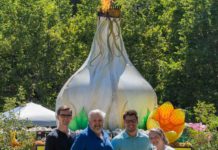GILROY
– More Gilroyans are registered to vote in Tuesday’s election
than in past contests, but that doesn’t mean more will vote.
GILROY – More Gilroyans are registered to vote in Tuesday’s election than in past contests, but that doesn’t mean more will vote.
The Santa Clara County Registrar of Voters said 17,611 Gilroy residents were registered by the Feb. 17 deadline. That’s 316 more people than registered for the City Council election in November.
As Gilroy’s population swelled in the 1990s, its number of registered voters grew despite a mid-decade slump, according to statistics provided by City Clerk Rhonda Pellin. The number of people who actually vote, however, has decreased consistently over the past decade. Only 26.8 percent of Gilroy’s registered voters went to the polls in the 2003 City Council election; even with absentee ballots, the percentage was less than 30. Ten years before, 40.2 percent voted.
One indicator of voter interest or apathy is the number of absentee ballots requested and returned. Countywide, 35 percent of 131,886 absentee ballots had been returned as of Thursday afternoon, according to Registrar of Voters spokeswoman Elma Rosas.
More than 2,600 Gilroyans requested absentee ballots for this election, but Rosas did not know how many of those had been returned as of Thursday.
“Usually, we get a higher number of absentee ballots returned on Friday, Saturday and Monday, and of course on Election Day,” Rosas said.
Polls are open from 7 a.m. to 8 p.m. Voting will be by touch-screen computers.
Perhaps the constant media swirl surrounding the Democratic presidential candidates will help prompt local registered voters to make their voices heard. Nearly half of Gilroy’s registered voters – 8,600 – are registered as Democrats. There are 5,363 registered Republicans, 386 American Independents, 118 Libertarians, 89 Greens, 51 Peace and Freedom Party members, 22 members of the Natural Law Party and 32 who stated unqualified parties.
There are also 2,950 people who “decline(d) to state” a party on their registration forms. These people will still be allowed to help the Democrats pick their contender for the Nov. 2 general election.
Unlike in past years, the Democratic Party will allow those who declined to state a party to vote among its many presidential candidates, which include John Edwards, John Kerry, Dennis Kucinich, Lyndon Larouche, Al Sharpton and five write-in candidates. Carol Moseley Braun, Wesley Clark, Howard Dean, Dick Gephardt and Joe Lieberman have dropped out of the hotly contested race.
Only registered Republicans will be allowed to vote for that party’s presidential candidate. President George W. Bush is the only name on the ballot, but seven write-in candidates are also vying.
Both the Democratic and Republican parties will let independents vote in their other primaries on the ballot, for seats in the U.S. Senate, House, state Senate and Assembly. The only exception is that party members alone can vote for members of party central committees.
The American Independent Party allows undeclared voters to vote for any of its candidates, but it has no contested primary races and only two candidates: Michael Peroutka for president and Don Grundmann for U.S. senator.
There are 2.4 million registered California voters who declined to state a political party, according to state Democratic Party Chairman Art Torres. About 700,000 of these voted in the last presidential primary in March 2000, but only registered party members’ votes were counted.
The other three parties on the ballot – Green, Libertarian and Peace and Freedom – will limit voting to registered party members.
For president, Greens offer four choices, three of them Californians: recent gubernatorial candidate Peter Camejo, of Oakland, David Cobb, of Eureka and Kent Mesplay, of La Mesa. The fourth, Lorna Salzman, is based in New York.
Libertarians have three options for the presidency: Michael Badnarik, Gary Nolan and Aaron Russo of Los Angeles.
The Peace and Freedom Party has two – Socialist Walt Brown and imprisoned Native American activist Leonard Peltier – plus one write-in.
Democratic U.S. Sen. Barbara Boxer is running for re-election, and Republicans have 10 candidates vying for her seat: Danney Ball, Toni Casey, Barry Hatch, Bill Jones, Howard Kaloogian, Rosario Marin, Bill Quraishi, James Stewart, Tim Stoen and John Van Zandt. Libertarians have two: Jim Gray and Gail Lightfoot. In addition, the Peace and Freedom Party has Marsha Feinland and the American Independents have Grundmann.
The House of Representatives primaries are uncontested, both for District 14, which includes Gilroy, and District 11, which includes Morgan Hill.
The only contested primary for state Legislature is for the departing state Sen. Bruce McPherson’s District 13 seat, which represents Gilroy. There are three Democrats (Elaine Alquist, Manny Diaz and Jose Medeiros) two Republicans (Shane Patrick Connolly and Andrew Abe Diaz) and two Libertarians (John Webster and Michael Laursen).
Also on the March 2 ballot are two races for county Superior Court judges. For Office 7, voters can choose Griffin Bonini, Lance Burrow or Enrique Colin. For Office 18, they have Teresa Guerrero-Daley and William Monahan.
There is one race for party leadership. Republicans in South County (county District 1) can vote for six of the following seven central committee candidates: Donna Courtright, Mike Davis, Jane Howard, Matthew Mo, Steve Moore, Jeffrey Parrott and Mark Zappa.













